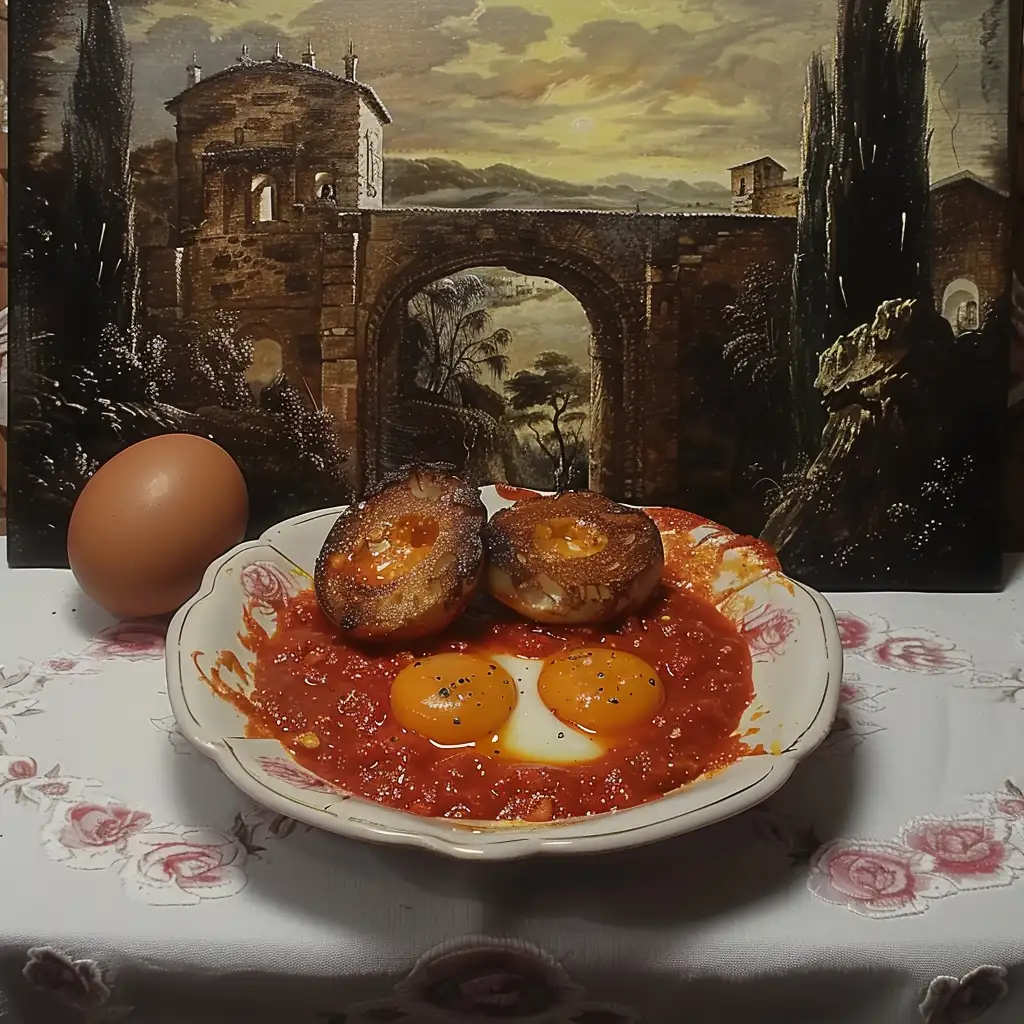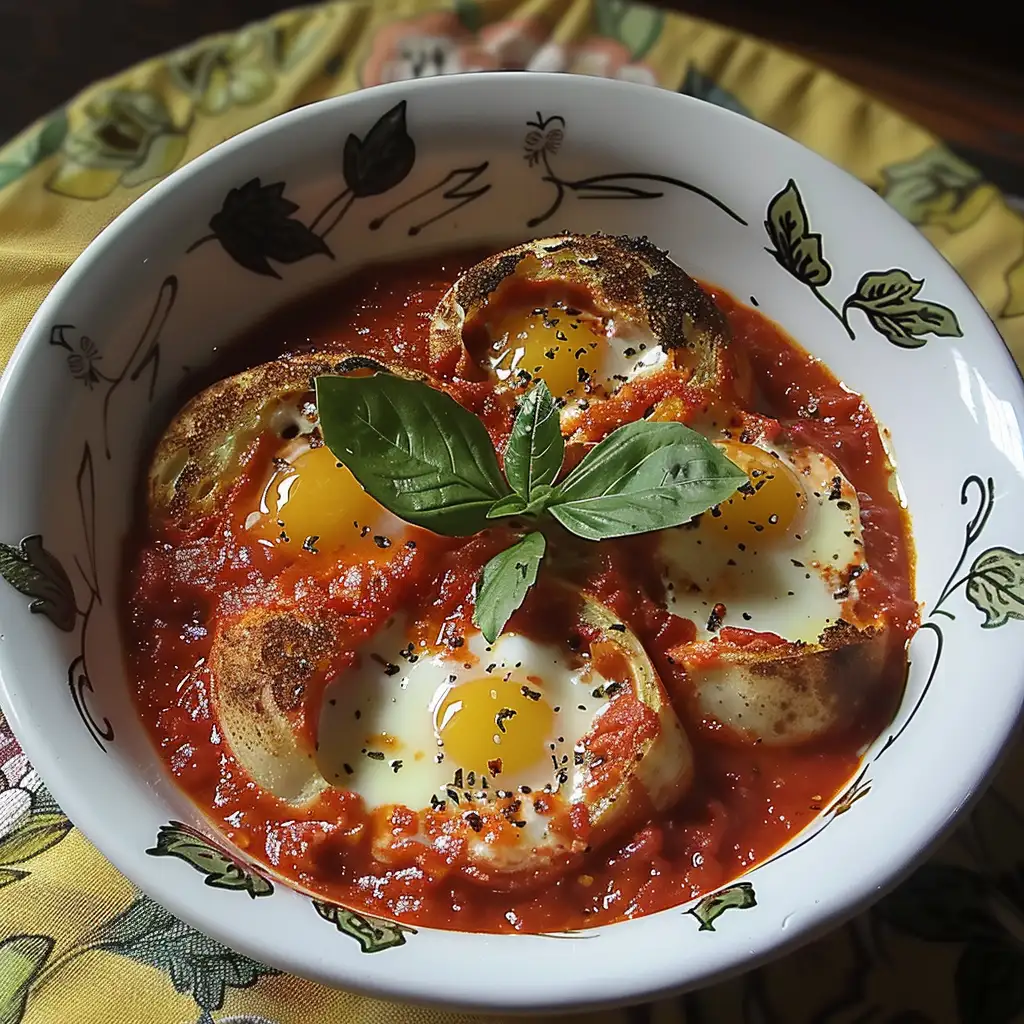Introduction to Uova in Purgatorio
Italian cuisine is revered for its simplicity, where the quality of ingredients speaks louder than complex cooking techniques. At the heart of this culinary philosophy lies a dish that beautifully encapsulates the essence of Italian cooking: Uova in Purgatorio (Eggs in Purgatory). This dish, minimalistic in its ingredient list, showcases the Italian knack for transforming simple elements into culinary masterpieces. The foundation of Italian cooking lies in its ability to highlight the natural flavors of fresh, high-quality ingredients, making each dish a celebration of purity and taste.
Origins and Cultural Significance of Uova in Purgatorio
The story of Uova in Purgatorio begins in the vibrant locales of Naples, a city that has long been a crucible of culinary innovation. The name itself, Eggs in Purgatory, evokes imagery of eggs gently poached in a bubbling tomato sauce, akin to souls seeking redemption in the flames of purgatory. This poetic metaphor is deeply rooted in the Catholic traditions of Italy, where food often carries symbolic meanings.
- The dish’s name reflects the deep intertwining of food with cultural and religious narratives in Italian society.
- Uova in Purgatorio is more than just a meal; it’s a story on a plate, marrying the simplicity of ingredients with the richness of Italian culture and history.
Regional variations of this classic dish further illustrate the diversity within Italian cuisine. While the Neapolitan version emphasizes the purity of tomato sauce and eggs, other regions incorporate local flavors, adding ingredients like olives, capers, or chili flakes to create a more robust and spicy rendition. Despite these variations, the core essence of Uova in Purgatorio remains unchanged: a celebration of simplicity, quality, and tradition.
For those keen on delving deeper into the Neapolitan cuisine and exploring the myriad ways this dish can be adapted, The Mediterranean Dish offers a treasure trove of information and recipes that pay homage to the rich culinary heritage of Italy. Through this exploration, one can appreciate not only the diversity of Italian cooking but also the shared love for food that unites its people across regions.
Uova in Purgatorio serves as a delicious testament to the Italian culinary ethos, where simplicity is the ultimate sophistication. It invites us to explore the depths of flavor that can be achieved with just a few ingredients, reminding us of the power of food to convey culture, tradition, and emotion. As we delve into the origins and variations of this dish, we are reminded of the rich tapestry of Italian cuisine, a blend of history, culture, and gastronomy that continues to captivate and inspire.

The Recipe and Variations
Embarking on the culinary journey of creating Uova in Purgatorio, one must start with the essentials. This dish, emblematic of Italian simplicity and flavor, requires only a handful of ingredients and some basic kitchen tools.
Basic Ingredients and Kitchen Tools Needed
To bring this dish to life, you’ll need:
- Eggs: The centerpiece of the dish, symbolizing purity and renewal.
- Tomatoes or passata di pomodoro: The soulful sauce in which the eggs are poached.
- Onion and garlic: The aromatic backbone of the sauce.
- Basil: A hint of freshness to balance the richness.
- Olive oil, salt, and pepper: For cooking and seasoning.
- Optional: Red pepper flakes for a hint of spice, or parmesan cheese for a savory finish.
In terms of tools, a shallow pan or skillet, a wooden spoon, and a food mill (if using whole tomatoes) are essential. These items help in creating a dish that is as beautiful to look at as it is delicious to eat.
Step-by-Step Cooking Instructions
- Start with the Soffritto: Heat a generous amount of olive oil in your skillet over medium heat. Add finely chopped onion, cooking until soft and translucent, about 5 minutes. Stir in the garlic, cooking for another minute until fragrant. This soffritto forms the flavorful foundation of your sauce.
- Prepare the Tomato Sauce: If using whole tomatoes, pass them through a food mill into the skillet to join the soffritto. For passata, simply pour it in. Add a whole basil leaf, reduce the heat to low, and let the sauce simmer gently for 10-15 minutes, allowing it to thicken and the flavors to meld.
- Poach the Eggs: Crack the eggs one at a time into a small cup, then gently slide them into the simmering sauce, ensuring they are evenly spaced. Cover the skillet and let the eggs cook until the whites are set but the yolks remain runny, about 4-6 minutes.
- Season and Serve: Season the dish with salt and pepper to taste. If desired, sprinkle with red pepper flakes or grated parmesan. Serve hot, accompanied by crusty bread for dipping into the sauce and egg yolks.
For those looking to perfect their soffritto technique or explore different ways to poach eggs, Savoring Italy provides invaluable tips and insights into Italian cooking methods that can elevate your Uova in Purgatorio to new heights.
Variations of the Recipe
Uova in Purgatorio is a versatile dish, easily adapted to suit different tastes and occasions:
- Puttanesca-Inspired: Add capers, olives, and anchovies to the tomato sauce for a bold twist.
- Vegetarian Option: Include spinach, mushrooms, or bell peppers for extra texture and nutrition.
- Cheesy Delight: Before serving, top with a generous sprinkle of grated parmesan or pecorino cheese for a rich, savory note.
These variations not only add diversity to the dish but also showcase the adaptability and creativity inherent in Italian cooking. By experimenting with different ingredients and flavors, one can discover new dimensions of this classic recipe, making each rendition uniquely delightful.

Variations of the Recipe
Uova in Purgatorio, while simple in its essence, offers a canvas for culinary creativity. The inclusion of ingredients like red pepper flakes, parmesan cheese, olives, and mushrooms can transform the dish, catering to various tastes and occasions:
- For the Spice Lover: Adding red pepper flakes introduces a subtle heat that elevates the dish, perfect for those who appreciate a bit of spice in their meals.
- Cheese Enthusiast: A sprinkle of parmesan cheese adds a savory depth, making the dish more indulgent and comforting.
- Mediterranean Twist: Incorporating olives and capers lends a briny, complex flavor profile reminiscent of a puttanesca, ideal for a brunch or light dinner.
- Vegetarian Delight: Adding mushrooms or spinach not only boosts the nutritional value but also provides a hearty texture that satisfies any appetite.
These variations not only broaden the appeal of Uova in Purgatorio but also demonstrate the dish’s versatility, making it suitable for everything from a quick weekday breakfast to a leisurely weekend brunch.
Additional Sections
Serving Suggestions and Pairings
To fully enjoy Uova in Purgatorio, consider these pairings:
- Bread: A crusty, artisanal loaf for dipping into the rich tomato sauce and egg yolks.
- Wine: A light, acidic white wine like Pinot Grigio complements the dish’s flavors, balancing the richness of the eggs and the tanginess of the tomato sauce.
- Salad: A simple green salad dressed with olive oil and lemon offers a refreshing contrast to the dish’s warmth and richness.
These suggestions aim to create a balanced, enjoyable meal experience, elevating Uova in Purgatorio from a simple dish to a memorable feast.
Nutritional Information
Uova in Purgatorio is nutritionally balanced, providing a good source of protein from the eggs, antioxidants from the tomatoes, and healthy fats from olive oil. While relatively low in carbohydrates, serving it with whole grain bread can add fiber, making it a well-rounded meal.

FAQs
- Best Type of Tomatoes: San Marzano tomatoes are ideal for their sweet flavor and low acidity, but any ripe, quality tomatoes will do.
- Perfect Egg Consistency: To achieve perfectly poached eggs, simmer the sauce gently and cover the pan to evenly cook the eggs without overcooking the yolks.
- Storing Leftovers: Cool the dish quickly and refrigerate in an airtight container for up to two days. Reheat gently to avoid overcooking the eggs.
For more detailed guidance on selecting ingredients and achieving the perfect consistency, Savoring Italy offers expert advice and tips that can help enhance your cooking experience.

